Site of the Week 4/4/2025: From the Poconos to Scranton
A visit to many of the sites in Pennsylvania's Poconos, plus Bold Gold's stations in Scranton
Text and photos by SCOTT FYBUSH
We’re playing some big games with the timeline in this week’s installment of Site of the Week in the interest of narrative consistency. If you’re driving from Winslow and Holbrook, Arizona (as seen in last week’s installment) to Grants and Albuquerque, New Mexico (coming up in the next few weeks), you’ll pass through Gallup, New Mexico along the way. We did just that in April 2011 as we zipped eastward to our first night on the road in our second “Big Trip” of the year – but we didn’t stop for much more than a few legal IDs at that point, because the evening was getting late and we still had a studio visit ahead of us before the night was over. So what you’ll see here today are actually some photos taken near the end of the trip, almost a week later – plus a few more shot in August 2011 on what turned out to be a return trip to Gallup as we helped a friend drive very quickly across the country to a new job.
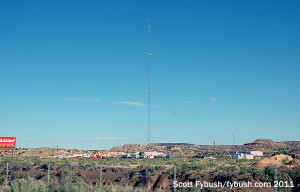 |
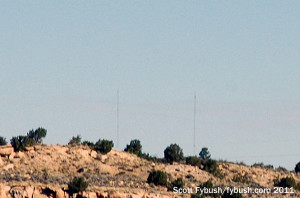 |
There are only about 20,000 people in Gallup city limits, and about 70,000 in McKinley County, but by virtue of being the biggest city between Flagstaff and Albuquerque, Gallup functions as the business hub for an area hundreds of miles across, especially stretching up north into the Navajo Nation. The county is more than 75% Native American, which goes a long way toward explaining why the oldest station in town speaks a language we can’t even begin to understand.
There aren’t many other languages that sound at all like Navajo, which makes up most of the programming at KGAK (1330). As best we can tell from the old Broadcasting Yearbook issues at AmericanRadioHistory.com, there’s always been at least a little Navajo programming on KGAK (the “Navajo Hour”) going right back to its debut in 1946, but the station was mostly English-language for its first half-century or so on the air before coming under its current ownership and goiug “All Navajo, All The Time” circa 1994.
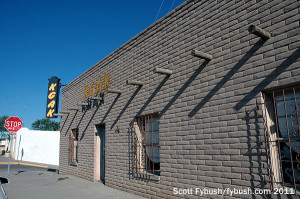 |
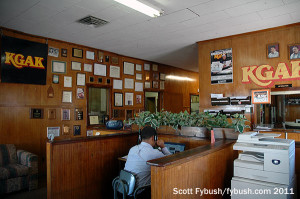 |
These interior photos of KGAK come from our cross-country trip later that summer, when we stopped back in Gallup to say hello to station manager David Singer and have a look around the facility at 401 E. Coal Avenue, a block south of the old 66 route through town.
(We’d met him on our April visit, too, but in a completely different, non-radio context that we’ll recount someday when we write the book, “The Only Passover Seder in Gallup, New Mexico.” No, really.)
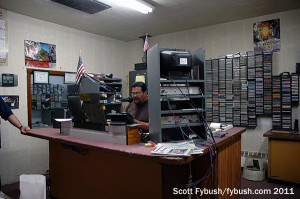 |
 |
In any event, when we finally made it inside the studios later that summer, we saw a control room and facility built in the classic style, complete with pegboard studio walls and a (decommissioned but very cool) cart-based automation system off in the corner. That’s Jerry “The Moose” Murphy on the air, and we hope whatever he was saying about our visit was complimentary, because beyond a mention of our names, we couldn’t understand a word of it!
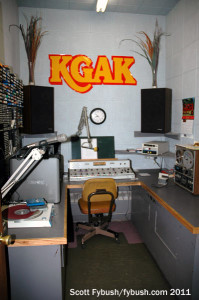
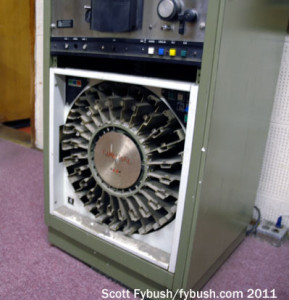
(Navajo radio, as we’ll see again in several upcoming installments, is full-service radio at its best: as spread out as the reservation is, radio still serves a vital message-board function in getting news out to isolated residents. A common feature of these stations is a little booth in the lobby where people can come in and record messages to be broadcast, which is sometimes the only way to let distant relatives know of news such as a hospital stay.)
There’s a smaller production studio next door to the big control room (which has since been renovated, I’m told), and there’s a table right in the control room where we ended up eating breakfast that August morning – a breakfast of some of the very finest green chile burritos your editor has ever eaten. The STL tower above the building points more or less due north across I-40 at the buttes just north of town, which is where KGAK’s two-tower array sits. KGAK runs 5000 watts by day, 250 watts at night, and it signs off nightly around 10 PM.
The other AM signal in town came along in 1959: KYVA (1230) transmits from a site just off the north side of I-40 on the east side of Gallup, and it’s part of Millennium Media’s cluster in town, which we find at a modern-looking studio building on Aztec Avenue in downtown Gallup. In addition to KYVA itself, there are the two oldest FM signals in town: KYAT (94.5) started out in 1974 as KOVO, a sister station to KYVA, and had become hot AC “Star” when we came through in 2011, later flipping to all-Navajo as a competitor to KGAK; KXXI (93.7) started out in 1975 as KQNM, a sister to KGAK, and these days it rocks out as “93X.” The third FM here is much newer: KYVA-FM (103.7) is licensed to Church Rock and runs classic hits.
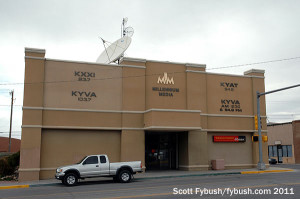 |
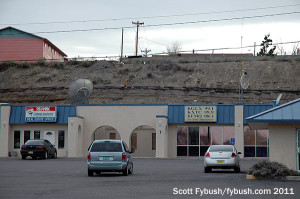 |
The other cluster operator in town is Clear Channel, which ended up with three FMs here as part of its acquisition boom in the early 21st century. Located in the Cedar Hills Plaza south of downtown, this cluster includes country KGLX (99.1, simulcast way up north in Navajo country on KFXR-FM 107.3 Chinle AZ), top-40 KXTC (99.9 Thoreau, which is pronounced “Threw” around here) and rock KFMQ (106.1).
With the exception of KFMQ, whose transmitter site we’d have seen if we’d continued just a little south of the Clear Channel studios, all the Millennium and Clear Channel FMs are up in the mountains at a site about five miles north of Gallup. That site is also home to public radio KGLP (91.7) and to K-Love outlet KLLU (88.9); its EMF sister station KGGA (88.1) broadcasts Air 1 programming from a site near the KGAK towers.
Thanks to KGAK’s David Singer, Melissa Jordan and Jerry “The Moose” Murphy for the tour, and the burritos!
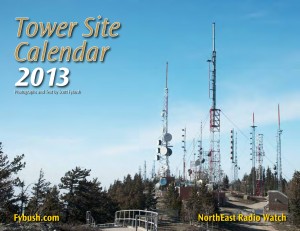 It’s 2013! Do you have your Tower Site Calendar 2013 yet? We’ve still got some left, and they’re shipping right away from the all new Fybush.com store! Order now and your wall can be festooned with New Mexico and much more all through 2013. (We’ve also got the very last FM Atlas copies available for sale.)
It’s 2013! Do you have your Tower Site Calendar 2013 yet? We’ve still got some left, and they’re shipping right away from the all new Fybush.com store! Order now and your wall can be festooned with New Mexico and much more all through 2013. (We’ve also got the very last FM Atlas copies available for sale.)
Want access to more than a dozen years’ worth of Tower Site of the Week? All our archives, fully searchable, are available to Fybush.com subscribers – and you get full access to NorthEast Radio Watch, too! Subscriptions start at just $15. Sign up here!
And don’t miss a batch of Gallup IDs next Wednesday, over at our sister site, TopHour.com!
Next week: Grants, New Mexico, 2011
A visit to many of the sites in Pennsylvania's Poconos, plus Bold Gold's stations in Scranton
In this week’s issue… Remembering Pittsburgh's Quinn - Seven Mountains enters Harrisburg - My launches new brands - Ryan out at B101 - More cuts at Radio Vermont - Another AM deleted
Tower Site goes Jeeping (and fixing a flat tire!) up in the mountains of northwest New Jersey
In this week’s issue… New signal for Boston's WJIB - "New Standards" changes stations - New home for Maine FM - Remembering NYC's Diaz, Maine's "Mr. Mike," Albany's McGrath, Rochester's Petschke